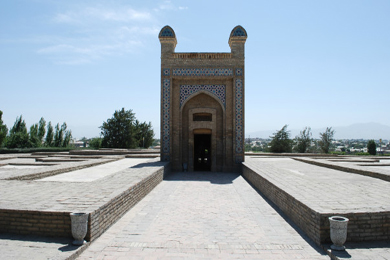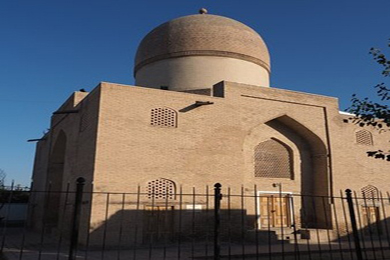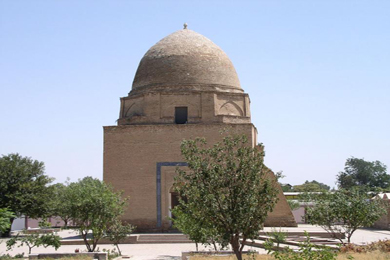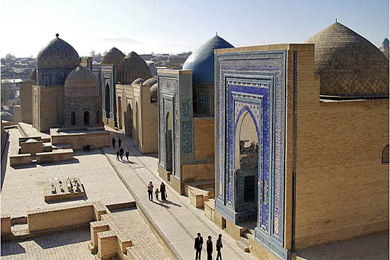Sights Of Samarkand
History of Samarkand - this legendary and unique city - contains over 2000. Modern Samarkand - the second city of Uzbekistan after Tashkent on population and the territory, industrial value. Zaravshan is located in a left-bank hilly part of an average watercourse. The nature endowed Samarkand with fine climate and clear water - it was stretched in one of heavenly spots of the earth Uzbek. The main waterway of the city are the Zarafshan River, canals Dargom, Siab, Shau-a gift.
Bridge water divider (head of the 16th century). The remains of the bridge of a water divider through Zerafshan are a monument of material culture, located is slightly lower than the modern railway bridge. As notes of the geographer’s travelers visiting the valley testify, approximately even more ancient bridge built at Temuridakh, and to it - the bridge relating approximately by 8-9 centuries was in the same place. The bridge a water divider was built at the khan Sheybani at the very beginning of the 16th century. Now from the bridge only one brick arch remained
- Details
- Category: Sights Of Samarkand
- Hits: 2
BAGI-MAIDAN PARK (15th century). Far back in the past at a foot of Chup-Ata slopes one of the most beautiful country parks was created. Its breakdown was begun at Temurs and finished by Ulugbek. There was a two-storied Chilsutun palace (i.e. "forty-columned").
- Details
- Category: Sights Of Samarkand
- Hits: 2
Mazar Chupan-ata (15th century) located to the northeast from Samarkand was constructed in honor of the mythical Saint of "the father of shepherds" whose cult was long since popular in the people, especially among cattle-farmers. It not over - a sepulchral construction, not the mausoleum. On the architecture - it is the mausoleum though archaeological openings did not find in it either burial, or a crypt.
- Details
- Category: Sights Of Samarkand
- Hits: 2
Ulugbeka observatory (1428-1429). It is built on one of the hills of Samarkand. It was the three-storied, covered with color tiles building of a round form with a diameter of 46 m and not less than 30 m high. In the main hall the enormous tool for observation of the Sun, the Moon and other stars of the heavenly arch was located.
Basis of observatory was the huge goniometer (a vertical circle) which radius of a circle equaled 40,212 m, and length of the arch was 63 m the main tool - a sextant - was focused with an amazing accuracy in the area of a meridian from the South on the North.
- Details
- Category: Sights Of Samarkand
- Hits: 2
Mausoleum of AksarayThe lack of historical data does construction a little mysterious. Assume that the mausoleum could serve as a family tomb for descendants Timurids in the male line. It was erected in the 70th of the 15th century when burials filled Gur-Emir and rooms, adjacent to it. Externally the Joint stock company Shed seems unattractive - is deprived of a decor, the dome remained unfinished. Some incompleteness is felt.
- Details
- Category: Sights Of Samarkand
- Hits: 2
Mausoleum Rukhabad. Near Gur-Emir there is a small mausoleum Rukhabad (in translation means "Monastery of spirit"), in whom the 10th is buried sacred a century the sheikh Burkhoniddin Sagaradzhi, his wife Bibi-Khalifa and their 10 children. Burkhoniddin Sagaradzhi conducted exclusively just image of a zhikhzna. He was married to the Chinese princess and died in China. The body of the Saint was delivered to Samarkand and buried by his children here. Sagaradzhi wanted it. Which called Samarkand "the city of God". The mausoleum is built in 1380, by request of Temur and by council Seyid Bereke's World.
- Details
- Category: Sights Of Samarkand
- Hits: 2
Necropolis of Shakhi-Zinda (the XIV-XV vv). It consists of the mausoleums, which were consistently attached one to another within centuries. The entrance Shakhi-Zinda portal finishing all ensemble was constructed by order of Ulugbek. The inscription over an entrance says: "This majestic building is founded by Abdulazizkhan. the son Ulugbek - Guragan, the son Shah - Rukh, the son Amir Temur - Guragana, in 883 g (1434). Long time was considered that in the first mausoleum the friend Ulugbek, the associate on scientific activity famous astronomer Kazy-Rumi's back is buried at the left. However, researches of scientists proved that in this mausoleum there are women's burials.
- Details
- Category: Sights Of Samarkand
- Hits: 2
The ancient settlement Afrasiab (the 7th century BC - HSh of century AD). Stores the remains of ancient Samarkand destroyed by Mongols in the subsoil. The name "Afrosiab" is connected with a name of the hero of the ancient epos "Shakhna-Me" - Afrosiab. Mighty lord Turana. Nowadays Afrosiab - a huge congestion of lifeless hills. But far back in the past life boiled here. The fixed interest of scientists in the ancient settlement Afrosiab is also explained by it.
- Details
- Category: Sights Of Samarkand
- Hits: 2
Bibi Hanym's mosque — the huge cathedral mosque, once the biggest mosque in the Islamic world and the biggest building of old Samarkand. It is constructed by order of Temur in honor of a successful campaign to India in 1399. Construction continued 5 years, but in view of the huge sizes, soon the mosque began to collapse. Later, the mosque turned into the colourful symbol of Samarkand surrounded with numerous legends.
- Details
- Category: Sights Of Samarkand
- Hits: 2
In a picturesque corner of Samarkand, in the ancient mansion belonging to the rich merchant Abram Kalantarov, built on the project of the architect E.O. Neleh in style of eclecticism at the beginning of the 20th century in 1981 the regional museum of local lore was open. The building of the museum is considered a monument of architecture and is protected by the state. All halls of the building are located vryad, forming a suite. On the first floor the exposition lighting history of development of edge since the most ancient times before the beginning of the 20th century is placed.
- Details
- Category: Sights Of Samarkand
- Hits: 2
The square Registan — the majestic ensemble consisting of 3 madrasahs and the mosque built during the period from 15 to 17 centuries. Ulugbek's madrasah — the oldest building on the square, is constructed by order of Ulugbek (grandson Timur) in the 15th century. Two others are constructed in the first half of the 17th century by order of the governor of Samarkand — Yalangtush — Bakhadura.
- Details
- Category: Sights Of Samarkand
- Hits: 3















